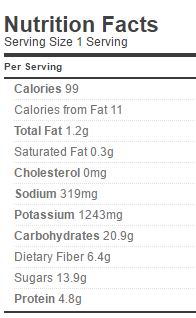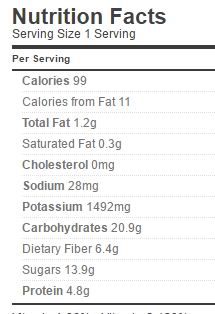Delicious home-canned pizza sauce takes you one step closer to quick, affordable and healthy homemade pizzas.
For a pizza base, you can buy a ready-made one at the store, or, make pizza dough for pennies in your bread machine.
We chose to can this sauce in smallers jars, which more closely approximate the size of pizza sauce tins one would buy at the store.
The Ball / Bernardin Complete Book, from which this recipe comes, says, “Feel free to add more oregano, pepper and garlic powder, but do not change the proportion of tomato purée to lemon juice.”
A quarter-litre (½ US pint) jar makes enough to very generously cover a 35 cm (14 inch) pizza base. If you think you might ever make smaller or personal size pizzas, you may wish to consider canning some 125 (4 oz) jars for that use.
See also: Chicken wing sauce
The recipe
Jar size choices: Quarter-litre (½ US pint / 8 oz) OR half-litre (US pint / 500 ml / 16 oz)
Processing method: Either water-bath or steam canning
Yield: 4 x half-litre (US pint / 500 ml / 16 oz) jars
Headspace: 2 cm (½ inch)
Processing time: 35 minutes either size jar

Pizza Sauce
Ingredients
- 3.25 litres plum tomatoes (puréed. 13 cups / 110 oz - SEE BELOW HOW TO MAKE) OR 2 litres (US quarts) of tomato passata (3 x 700 ml bottles)
- 125 ml lemon juice (bottled. ½ cup / 4 oz)
- 2 teaspoons oregano dried
- 1 teaspoon ground black pepper
- 1 teaspoon salt (OR non-bitter, non-clouding salt sub)
- 1 teaspoon garlic powder
Instructions
- If using fresh puréed tomato, make the purée as per directions in Recipe Notes.
- If using fresh puréed tomato, take that purée and put half in a large pot, bring to a rapid boil over high heat, stirring frequently. Add remaining purée a cup at a time, so that you don't lose the boil. This is to help prevent separation of tomato solids and water.
- If using passata, just empty jars into in a large pot, bring to a boil.
- Regardless of your starting base, add all remaining ingredients to pot.
- Bring back to a boil.
- If using fresh puréed tomato, boil hard uncovered stirring frequently, until you have the consistency of ketchup: 15 to 25 minutes.
- If using passata, simmer lively uncovered until you have the consistency of ketchup: about 10 minutes.
- Remove pot from heat
- Ladle sauce into heated jars.
- Leave 2 cm (½ inch) headspace.
- Debubble, adjust headspace.
- Wipe jar rims.
- Put lids on.
- Process in a water bath or steam canner.
- Process jars for 35 minutes; increase time as needed for your altitude.
Nutrition
Reference information
How to water bath process.
How to steam can.
When water-bath canning or steam canning, you must adjust the processing time for your altitude.
For salt substitute, Herbamare Sodium-Free was used as it is non-bitter and non-clouding.
Recipe notes
- Making fresh puréed tomato: You’ll need 4 kg (9 lbs of tomato. Wash them, and pass them through a food mill or strainer to remove the seeds, core, and peel. If you don’t have a food strainer or food mill, see here: Making tomato purée without a strainer or food mill. Yes, the recipe writers are counting on peeled tomato: most of the bacteria is on the tomato skin and they would have tested for that reduced bacterial level.
- Tomato passata is pure puréed plum tomato in a jar. It’s how Italians in Italy start almost all their tomato sauces at home. You must treat it as you would any tomato in canning recipes and acidify it, etc. See passata.
Recipe source
- Kingry, Judi and Lauren Devine. Ball / Bernardin Complete Book of Home Preserving. Toronto: Robert Rose. 2015. Page 366.
Modifications made:
- Salt-free alternative choice;
- Worked out equivalency for starting from passata
Nutrition information
Regular version
Per 1 cup (250 ml / 8 oz):
- 99 calories, 319 mg sodium
Salt-free version
Per 1 cup (250 ml / 8 oz):
- 99 calories, 28 mg sodium
* Nutrition info provided by https://caloriecount.about.com






Eric Krolik
Can you add sugar to the sauce and still safely water bath process?
Healthy Canning
Yes you may add some sugar or an alternative sweetener to the sauce. That counts as tweaking the seasoning.
Bean
Does processing time change if different spices are used?
Healthy Canning
No. See safe tweaking: https://www.healthycanning.com/safe-tweaking-of-home-canning-recipes/
Dianna
I made this recipe yesterday and canned in 4 oz jars. Today, I read an article that said the lemon juice must be added to each jar, not to the entire pot. Should I open the jars and freeze the contents instead? I’m new to canning and not confident about my abilities yet. Don’t want to poison my family!
Healthy Canning
This is a research-tested recipe, and the writers calls for it to be added to the pot.
patty
can u use fresh lemon juice? and “to the entire pot” means the pot of sauce? not the pot it boils in?
Healthy Canning
The writers of the recipe call for the lemon juice to be added to the pot that all the other ingredients are being mixed and boiled in. They want bottled lemon juice to assure a certain acidity for safety.
Kim
Add some fennel seeds and it will be much nicer
Kathy
Do I need to change the processing time if I want to use 4oz jars?
Healthy Canning
See canning with different canning jar sizes.
mindy
Just made this pizza sauce tonight. I made 1/2 the recipe and the only thing it needed was 2 tbl of organic cane sugar to cut the sharp acid flavor (I left the skin and pulp/seeds in). I got about 20 ounces from 6 1/2 cups of pureed tomatoes.
Healthy Canning
Some people taste the bitterness of the seeds more than others. It may be down to the type of tomatoes. “Organic” isn’t really relevant in terms of canning, regular would have done the same :}
Peeling, however, is another matter. Most of the bacteria on tomatoes clings tightly to the skins and not even vigorous washing gets it all off. In general, when a tested recipe calls for tomatoes to be peeled, that means that their labs tested for that reduced bacterial level going into the canner. They didn’t test for the more elevated bacterial levels with the peel going in, too. See here: https://www.healthycanning.com/peeling-tomatoes/